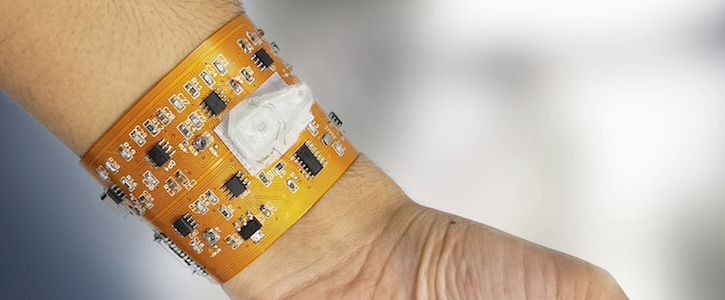Next-Gen Smartwatches Could Measure Blood Cells and Environmental Hazards
Is this what the future of wearables looks like?

Photo: Abbas Furniturewalla, Rutgers University.
Over the past few years, wearable technology has become ubiquitous among fitness freaks and many other people, too. Having an easy piece of tech that monitors heart rate, calories burned and activities is useful, but the next generation of the technology could do a lot more than that.
Researchers at Rutgers University—New Brunswick are working on a new system of wearable tech that expands the smartwatch into a far more functional medical device. In new research published in Microsystems & Nanoengineering, the researchers described a smart wristband capable of diagnosing everything from blood cancers to toxins in the air around the wearer.
>> READ: Digital Health Isn’t a Technological Revolution. It’s a Cultural One.
The “smart wristband,” as it’s called, isn’t as sleek and polished as a Fitbit, but researcher Mehdi Javanmard, Ph.D., told Healthcare Analytics News™ that further miniaturization is the next step. Right now, it’s a wide wrap of circuitry and sensors that connects wirelessly to a smartphone via Bluetooth, like its commercial predecessors. The difference is, the new wristband packs a lot more hardware. With a standard lancet prick (the wristband doesn’t have needles embedded in it, yet), people can use the wearable technology to analyze their blood cell counts, test for certain blood cancers, quantify bacteria and analyze proteins.
Before that happens, though, researchers have more work to do.
“Extensive assessments need to be performed, testing the device on large numbers of patients,” Javanmard said, emphasizing that they must make the device “more rugged.”
The device’s uses are an interesting combination of clinical and commercial.
On one hand (literally), a commercial user could wear a bracelet to monitor insulin levels or check the air quality outdoors when stepping out of the house for a run.
On a clinical level, the device could be put on discharged patients who need further testing, to provide immediate, up-to-date information to doctors without another visit to the hospital. Blood samples are fed into a small plastic channel on the device that’s embedded with tiny gold electrodes and analyzed by a micro-controller.
The researchers tested and developed the device for Android phones, but there’s nothing stopping it from being adapted to iOS or other operating systems.
“Current wearables can measure only a handful of physical parameters such as heart rate and exercise activity,” said Abbas Furniturewalla, the study’s lead author and former undergraduate researcher in the Department of Electrical and Computer Engineering, said in a news release. “The ability for a wearable device to monitor the counts of different cells in our bloodstream would take personal health monitoring to the next level.”
Javanmard mentioned in the release that a whole host of professions could benefit from the device, which could become a next-generation canary for miners to measure poisonous gases in their environment. And, of course, they’d also let every fitness-focused consumer fine-tune their body’s chemistry as well.
Get the best insights in healthcare analytics directly to your inbox.
Related
Healthcare, Wearables, and the Fourth Industrial Revolution
FDA Approves Wearable to Combat Opioid Withdrawals
Original Research: MDs Are Increasingly Recommending Wearables